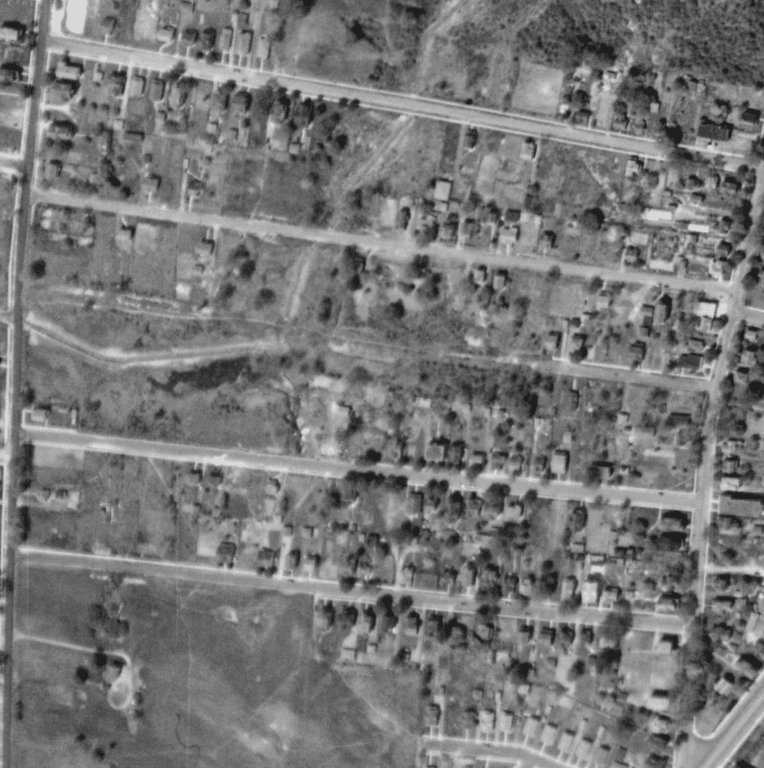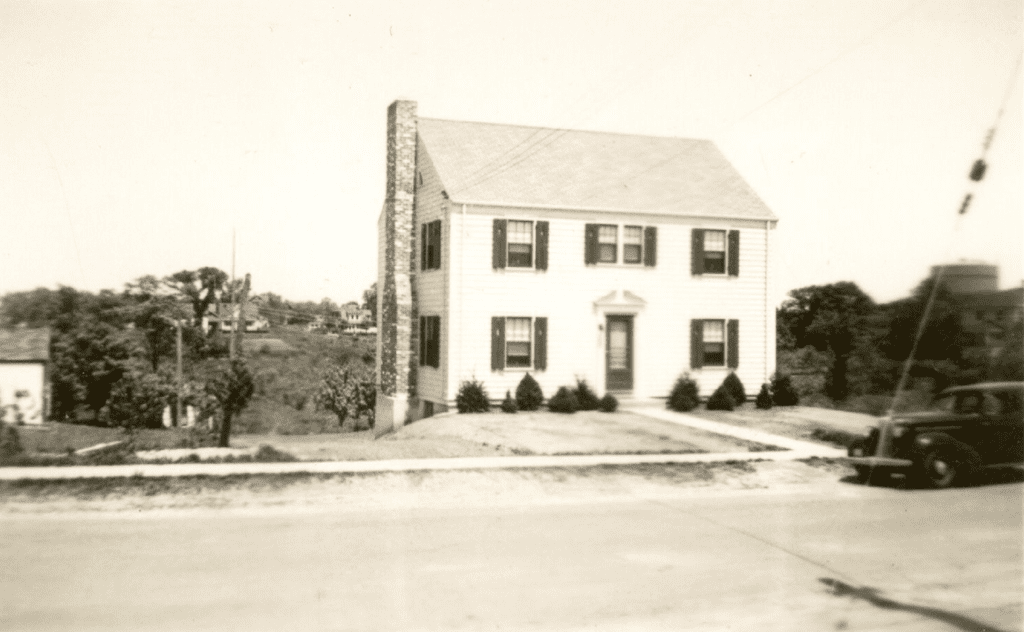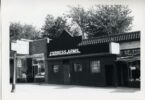Historian Jeff Murray takes a look into West Hartford’s past to uncover some surprising information, stir up some memories, or reflect on how much life has changed – or hasn’t changed at all. Enjoy this week’s ‘From West Hartford’s Archives’ …
By Jeff Murray
This is a photo of the house at 118 Levesque Avenue when it was purchased brand new in 1937 by the grandparents of Joan McAllister Kinsley, the contributor.
It was built by the prolific contractor Louis W. Slocum, who was responsible for dozens of houses in West Hartford. He built along the Boulevard, Whiting Lane, many on Walbridge Road, Bishop Road, Pleasant Street, and Norwood Road from 1914 through the 1920s.
Slocum stuck to individual houses through the 1930s, including 118 Levesque Avenue. Henri and Antoinette Faucher bought the house and moved in when Joan’s mother was 15 years old. While Henri was later a tavern owner in East Hartford, he worked as a house painter during the early Depression years and then as a gear cutter at United Aircraft before World War II; Antoinette was an assembler at a typewriter factory. During World War II, she worked as a machinist at Arrow Electric. They were French Canadian, born in the latter half of the 19th century, and naturalized as U.S. citizens in 1939.
Levesque Avenue, like Boulanger Avenue and Caya Avenue, is well-known for being part of West Hartford’s old “Frenchtown” neighborhood, but what isn’t as known is that these streets in this subdivision were all originally dead-ends when they were laid out in the 1890s. Bernard Caya, a house builder who immigrated to the U.S. in 1880 from French Canada, married Philomene, who had 14 children starting in the early 1880s. He bought land along Prospect Avenue and built a house at 117 at the corner of what would become Caya Avenue. With Eli Lavoie, another French Canadian who soon after built up a sizable ice business along Bloomfield Avenue, the two purchased 12 acres of land in 1895 at the south end of Prospect Avenue and laid out Levesque Avenue and Boulanger Avenue.
Boulanger was named after the Boulanger family, who bought some of this land from Caya & Lavoie in 1895, while Levesque Avenue was named after the Levesque family in Hartford. The streets that eventually became Mozart Street and Westphal Street were actually a separate land tract sandwiched between Caya’s holdings and owned by William Westphal, a German tobacco dealer in Hartford.

The owners of the Frenchtown neighborhood in 1896; note that the streets do not extend to Oakwood Avenue as they do today.
Through the 1890s and 1900s, individual lots on these streets were sold off to working-class families for new houses, many to French Canadian immigrants – like Charles and Odelia Dandurand, who came to the U.S. in the 1880s. Lots were also sold to families like the Merciers, Beaupres, and Beaudoins for houses along Prospect Avenue or at the entrances of these side streets. These houses were then either occupied by the owners or rented out.
People of many other nationalities, including Germans, Polish, Austrians, Swedes, and Irish, lived along these streets in the first decade of the 1900s. The working-class nature of this neighborhood meant that turnover was high during these years, ethnic tensions could be sporadically explosive, land changed hands often, and people occupied these houses for much less time. Nevertheless, expansion was on the horizon.
In 1903, Caya purchased a foreclosed house and 20 acres of land on both sides of Oakwood Avenue, and pushed for the extension of Caya Avenue to Oakwood, a process which surprisingly took several years. When this finally happened around 1907, he petitioned for an extension of the water main south along Oakwood Avenue, anticipating new construction opportunities along the south end of Oakwood Avenue. His son Wilfred, trained as a contractor like all of Bernard’s sons, built a house on the west side of Oakwood Avenue across from Caya in the early 1910s.
Wilfred built numerous three-family houses along the avenue, contributing to the building boom the town experienced during these years. Some of these houses would be later torn down for the I-84 highway and are forever lost. Some remain, like 270/272 and 253/255 Oakwood Avenue. They are easy to miss, but they are important reminders of the functional side of the old “tenement” housing in West Hartford.
When the area had been built up by 1920, this western extension of Caya Avenue was renamed “Wilfred Street.”
To fully understand the development of this neighborhood, however, it’s necessary to include the Benkert family. The reason that Levesque, Boulanger, and the other side streets were dead ends until the 1910s was because they had to end at the Oakwood Avenue farm owned by John Benkert and his wife Agnes since the Civil War. Born in the 1820s in Germany, they came to the U.S. in 1860 and settled along Oakwood Avenue. They had no children, but employed two to three farm laborers who boarded with them since the 1860s, all from the same region of Germany that they were from.
When John died in the spring of 1894, he left all the property to his wife Agnes. His will stipulated that after her death, the farm would go to his nephew, Anton Treuting. Unfortunately, there was not enough money to pay his funeral expenses and the property was foreclosed on for a number of years. Agnes removed to Hartford to live with her niece and after her death in 1911, the property, per the Benkert will, passed to Anton Treuting.

The Benkert farm in 1909 along Oakwood Avenue.
The Treuting family is not a name known today but was instrumental in more than one significant land transfer that shaped this town. His sister, Margaret, married a tobacco farmer named John Ziegler, and the couple lived on a tobacco farm on the south side of New Britain Avenue in Elmwood for more than 40 years. Their sale of the entire farm to a Hartford real estate company in 1919 paved the way for the subdivision of the land and the development of today’s Colonial, Somerset, Florence, and Elmfield Streets.
In 1916, land developer Fred Tobey purchased 20 acres of land on Oakwood Avenue from the Treuting family. On the west side, this purchase helped him complete a brand new subdivision extending to South Quaker Lane, which became Edgemere, Englewood, and Edgemont Avenues. Later, he would buy even more land and lay out Sidney Avenue and Hampton Avenue.
On the east side of Oakwood Avenue, this land sale from the Treutings allowed him to finally extend Levesque Avenue and Boulanger Avenue through the old vacated Benkert farm and connect to his other holdings across the avenue.
During this time, Levesque Avenue to the east saw the same types of improvement as the other streets. A bog hole was removed on the road, sidewalks were installed, electric lights were strung up, and it was partially paved. A grocery store was conducted at the corner of Prospect Avenue and building and veranda lines were established by the selectmen of the town. These original short dirt roads off Prospect Avenue were developed as part of the town’s initiative to provide better access from Prospect Avenue to the new Seymour Avenue School (now Smith School).
For the next two decades, individual lots were sold by the developer generally as investments, since by 1935, only three houses had been built on this extension of Levesque. One might think that business would be slow during the entire Great Depression, but it was after just the first (and worst) years ended that West Hartford experienced a building boom.

1934 aerial map of the neighborhood – Levesque Avenue is the first full street on the bottom. The many houses on the original east side and the lack of houses on the west side is one of the consequences of the Caya-Benkert division of land.
From 1937 to 1940, almost 2,000 new homes were constructed in town. During the early depression years, there wasn’t much money being loaned for home ownership, so it was generally cheaper to rent than to own; in many cases, due to high unemployment, many families doubled up in the same house, leaving a lot of other housing vacant. As unemployment numbers steadily went down in the mid-1930s and money freed up, there came a higher demand for separate homes and institutions began lending again. This meant that those who had held onto their land, especially in this neighborhood, could cash in on the higher demand to sell the lots to prospective homeowners and the building boom could set off. The land along Oakwood Avenue between Levesque and Mozart was therefore “opened up” and a total of 24 houses were built in just two years.
118 Levesque Avenue, built in 1937 for the Fauchers and the house featured in this article, was part of this housing surge. The houses that can be seen in the background of the photo are along Westphal Street across the wetlands at the west end of Mozart Street. Photographs like this one are indispensable not just to our local history, but also to American history. This photo is a snapshot of a small town emerging from the Great Depression.

118 Levesque Avenue. Photo courtesy of Joan McAllister Kinsley

Google Street view of 118 Levesque Avenue, 2022
Jeff Murray was born and raised in West Hartford and has been involved with the Noah Webster House & West Hartford Historical Society since 2011 when he was a high school student and won the Meyer Prize for his essay on local history. Jeff routinely volunteers as local history researcher uncovering information for numerous museum programs such as the West Hartford House Tour and West Hartford Hauntings. Jeff works as a data analyst at Pratt & Whitney.
Like what you see here? Click here to subscribe to We-Ha’s newsletter so you’ll always be in the know about what’s happening in West Hartford! Click the blue button below to become a supporter of We-Ha.com and our efforts to continue producing quality journalism.








